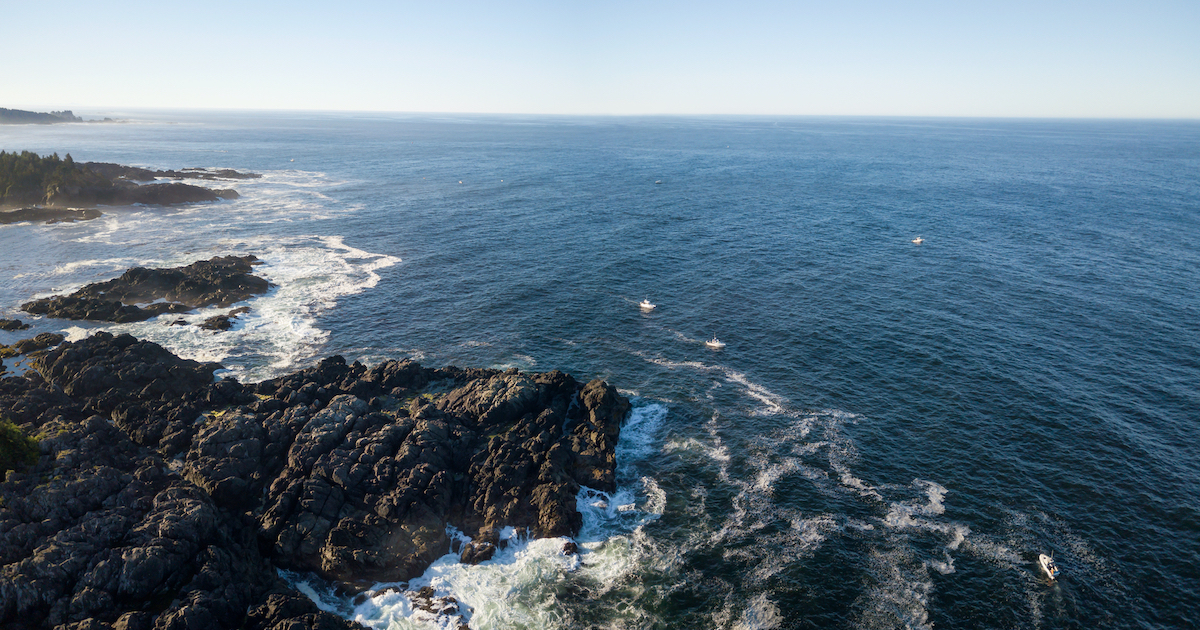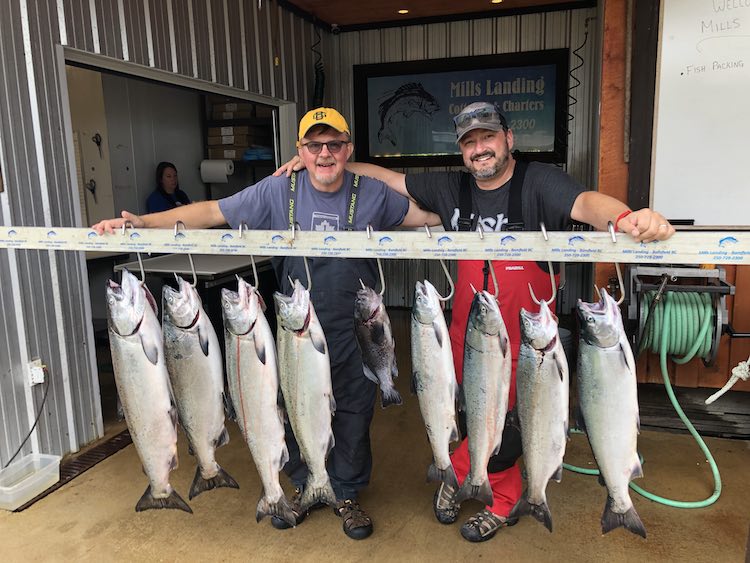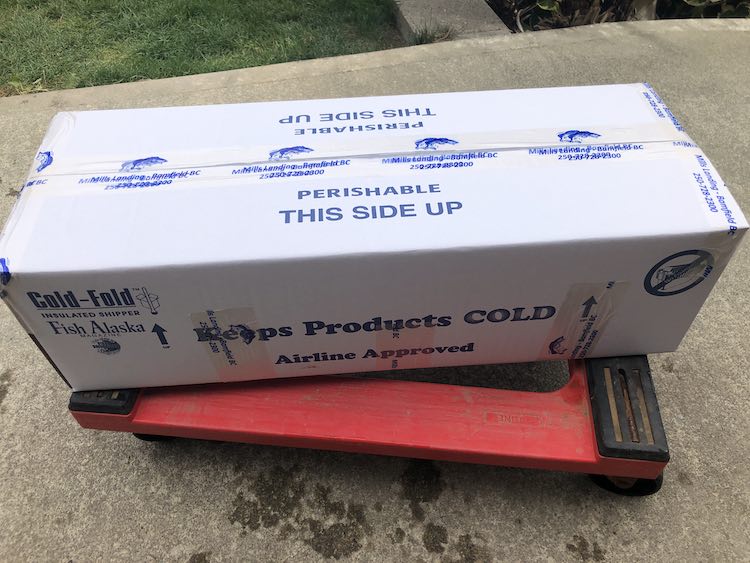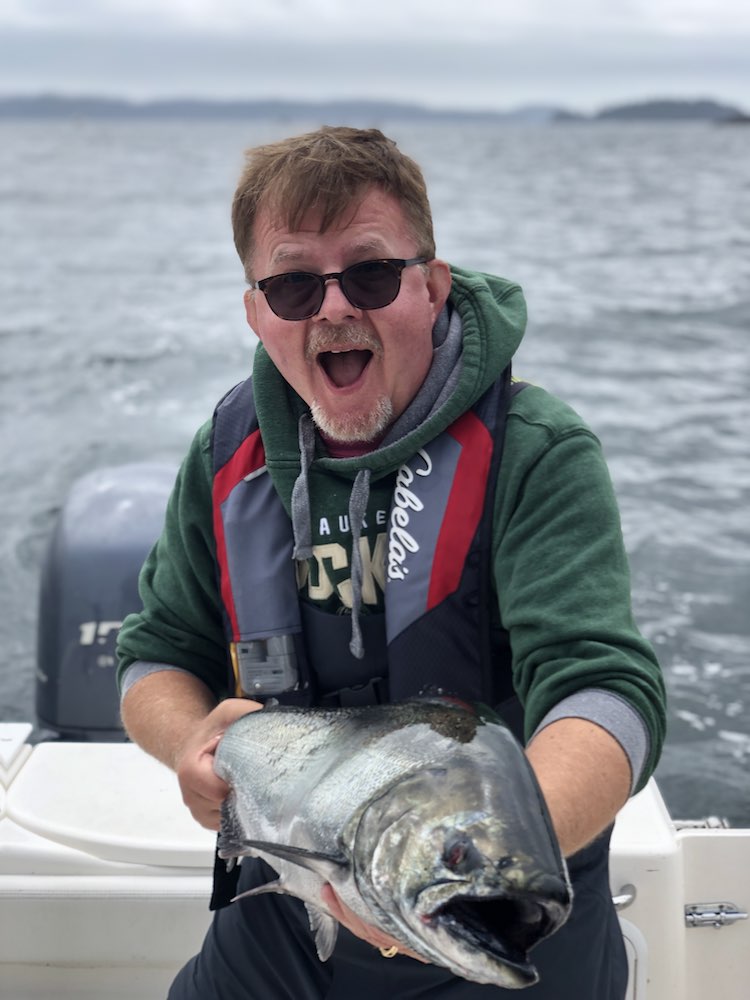
“Can we just not put the lines in the water for 10 minutes?”
I was exhausted and frazzled, but exhilarated, when I said that as we approached our limit on my third day fishing in Barkley Sound. That’s how fast they were hitting the anchovies off of Austin that day. Of course, that was a rookie question, and of course, the answer was “Heck, no!”
That Saturday afternoon was my third full day of the first salmon fishing trip of my life, and it was everything I’d been promised and more. I’ve known Island Fisherman publisher Joel Unickow for more than a decade. Every spring, he would tell me “You’ve got to come up to the island and fish. You won’t believe how amazing it is.” And every spring, I’d say “Maybe next year”—it’s a long trip from Wisconsin, and while I enjoy fishing, I wouldn’t call myself a fisherman. To be honest, as much as I love the outdoors, I’m more of a city guy—museums, art galleries, and people-watching is more my style.
But last year, I finally said yes, and discovered just what he and everyone else involved with the magazine has been bragging about. I spent 5 days in Nanaimo and Bamfield (well, mostly on the water in Barkley Sound), and I flew home with a cooler full of salmon, memories to last a lifetime, and the knowledge that I’d just experienced something so special I could hardly believe it actually happened. I’d say it was a once- in-a-lifetime experience, but I’m already figuring out how and when I can come back. Sure, the fishing was amazing—of course it was—but the whole experience is one I can’t wait to repeat, hopefully with my family next time.
ISLAND LIFE
Joel had all the gear, so all I had to pack was my clothes. He warned me that the weather on Vancouver Island was unpredictable, and that I should be prepared for cold, wind, rain, sun, and heat—all in the same day. I made sure to bring a pair of rubber-soled, waterproof shoes for the boat (a pair of closed-toed Keen sandals worked great) as well as a wide-brimmed hat, sunscreen, rash guard shirts, a thick hoodie, and shorts. Joel provided fishing bibs and rain gear, which we thankfully never needed.
I flew into Victoria from Milwaukee by way of Seattle. It was about a 7-hour trip, but it was an easy flight to SeaTac, and YYJ is a small airport. I’m used to traveling internationally for business, and so was expecting the usual interrogation at customs—“What brings you to Canada? What kind of business do you do? Who’s the DFO minister?”—but all I got was a friendly “Got all your luggage?” and I was on my way to the Travelodge in Sidney.
After a monster breakfast at the Five & Dime, Joel came and picked me up and gave me a whirlwind tour of downtown Victoria. I’d never been, and I was taken by its lovely gardens, quaint Victorian (duh) vibe, and the lovely marina. I even managed to snag a wonderful First Nations t-shirt for my wife at Northwest Origins while Joel circled the block in the Island Fisherman pickup truck (the locals will know the one, I’m sure), and then we were headed north.
Within a half-hour, the city might as well have been hundreds of miles away. We ascended quickly among the towering Douglas Fir, and this Midwesterner was blown away. We’ve got beautiful old-growth pines and cedars in the Chequamegon-Nicolet forest in northern Wisconsin, but it’s not the same. (For one thing, it’s flat and loaded with mosquitos, and I didn’t see one mosquito on Vancouver Island last August.) We stopped at the lookout point near Malahat and took it all in. “You get it now, don’t you?,” Joel asked. Yeah, I got it. The view was stunning, and even with the traffic racing past behind us, I was beginning to get a sense of just how tranquil Vancouver Island is.
We stopped in Cowichan Bay—a lovely little tourist and fishing town—to grab a quick bite at the Cow Bay Marine Pub and watch the kayakers for a bit before resuming our journey north. We had to stop in Duncan to check out West Coast Tees, where I was spoiled for choice. No cheesy souvenirs there; just first-class designs and great craftsmanship on all the merchandise. But the best part of the drive was the drive itself. I already felt the demands of work and home slipping away as I took in the view of the hills as we approached Nanaimo.
Once in Nanaimo, we had two obligatory stops: one for Nanaimo bars, which are every bit as wonderful as I’d been told, and one at Canadian Tire for my fishing license. If you’re coming from the U.S., you can purchase your license online before your trip, but be warned—the DFO sometimes puts limits on what you can bring back across the border with a license purchased online. The folks at the service desk made me name three Canadian bands before they’d give me the license. I knew they were just giving me a hard time, and luckily I passed, though not without getting a few laughs over how I pronounce “Chilliwack.”
Sure, it took us 4 hours to make the 2-hour trip, but we didn’t have to leave for Bamfield until the next morning, and I loved getting a little bit of the flavor of life on the east coast of Vancouver Island. If you’re coming to the island to fish, give yourself an extra day to enjoy everything else it has to offer.
ON THE WATER
After a lovely evening with Joel’s family, we packed up the boat and headed to Port Alberni. The scenery I’d experienced the day before was just a taste of even better things to come; the drive down Highway 4, past Cameron Lake, and into Port Alberni was simply beautiful. I do wish we’d had time to hike a bit in Cathedral Grove, but alas, we had to put the boat in before noon to catch the tide. We dropped off a few copies of the magazine at the Tyee Club headquarters next to Clutesi Haven Marina, and next thing I knew, we were on the water.
Now, if the drive was gorgeous, the trip down the inlet was absolutely breathtaking. Cruising along at 30 knots, I took picture after picture until I realized that iPhone photos could never do the scenery justice, and just focused on being in the moment amidst all this majestic beauty. Even with the clear evidence of logging, so many of the peaks that nestle the inlet are unspoiled, and I just got lost in the rock formations and trees. It wasn’t long until we entered Barkley Sound, and made our way to Swale and dropped our lines for the first time.
Over the next three-and-a-half days, what were initially nameless rocks became landmarks I knew by heart— Swale, Gibraltar, Reeks, Austin, The Wizard—and I can confidently say I got a taste of everything Vancouver Island fishing has to offer. In addition to being a seasoned fisherman, Joel is a tremendous teacher, and he patiently taught me how to do everything from using the downriggers to steering the boat to setting the hook to netting the fish (those YouTube videos he’d sent me helped, too).
And fish we did. That first afternoon, Joel manned the lines and played the fish, though I did manage to net at least one and bring it in to the boat. When we headed into Mills Landing in Bamfield, we brought 3 fish with us. We got all our gear up to the cottage and had some beverages with the folks down at the fish cleaning station, then fired up the grill and I had my first taste of fresh-caught Pacific coho. Needless to say, it was unlike any fish I’d ever tasted before, and I couldn’t wait to get back on the boat the next morning, and this time, hopefully catch a few myself.
On day 2, we headed down to the dock at 5 a.m., by which time the various guides were already on the water and heading into the sound. There’s nothing more peaceful than being on the water before the sun comes up, filled with anticipation for the day to come. We quickly headed to Fleming Island and joined a dozen or so other boats in the parade along the rocks, each one following well-understood but unspoken “rules of the road,” trolling along the island to the starboard side for a while, then making a u-turn and heading to the back of the line. It wasn’t long before I heard Joel yell “Fish on!,” but it was here I learned one of the first maxims of fishing: It is better to have fished and lost than not to have fished at all (or something like that). We played and lost a half-dozen, but that just whet my appetite for what was to come.
By mid-morning, we headed across the sound towards the Broken Group and tried our luck there, and it wasn’t long before we found the spot (not the “spot on the spot”—that came later). Within a half-hour of settling at Swale Rock, Joel spotted a light bite on one of the rods and yanked it out of the downrigger. (I was amazed at how quickly I was able to differentiate between the normal wind and wave action on the line and an actual strike, but I was even more amazed at how a seasoned fisherman like Joel could see the slightest bite.) He set the hook, and then I heard the words I’d been waiting for: “You want to play this one?” I grabbed the rod, hoisted the tip up, and started reeling, with Joel guiding me on when to reel and when to let the fish run out some line. Despite all the research I’d done ahead of time about how to play a big fish, I got my knuckles busted plenty before Joel reminded me to cup the reel while the fish took out the line. But after 10 minutes of playing the fish, I got it to the boat and Joel expertly netted it—a 13-lb coho, so big that we thought it was a Chinook before we took a closer look.
I’d already been loving the experience of being on the water and helping Joel boat a few fish, but the thrill of playing and landing a big salmon was unlike anything I’d experienced before, and I had a few more opportunities that day and the next. But our final day on the water was something else entirely. It started off slow again save for a nice black rockfish, but by early afternoon we’d found not just the spot, but the “spot on the spot,” just near Austin. So had about 30 other boats, though, and the next two hours were frenetic and stressful, but thrilling. For those two hours, we couldn’t put our lines in the water without getting a strike, and even though we limited out—four Chinook and four coho—we probably lost almost as many as we got in the boat, hence my rookie plea to give it a rest for a few minutes. Needless to say, I’m glad we didn’t, but it sure was tempting. In addition to the fish, I got a couple of great “fish stories” out of the experience, but if you want to hear those, you’ll have to wait until I’m back at the campfire in Bamfield.
BRINGING IT ALL BACK HOME
Over the course of four days, we’d caught and cleaned (well, Joel cleaned) our trip limit of salmon and a couple of rockfish, and the good folks at Mills flash-froze and vacuum packed all of it. I’d spent a fair amount of time researching and worrying about how I was going to get my portion of the catch safely through the 30-hour journey from Bamfield to Beaver Dam, Wisconsin. I considered taking the fish to St. Jean’s Cannery in Port Alberni and having them ship it to me, but towards the end of a fishing season, they’re so busy that I would have been lucky to get my fish by Christmas.
I couldn’t wait that long! I considered buying a cooler and getting some dry ice in Victoria (airlines only allow dry ice or gel packs), but I wanted to fill every square inch of space with fish, not ice.
But the folks at Mills told me I’d be fine just putting the flash-frozen fish in 50-lb-capacity airline cooler—basically, a lightly insulated, wax-coated cardboard box—when we left the lodge on Sunday afternoon, so long as I had a hotel in Victoria that could store it in a freezer until my flight early Monday morning. After a few phone calls, I found one (the Bedford Regency, but there are certainly others). I was dubious and a little worried—after all, this was precious cargo, and I would have been crushed to get home and open the box to find it full of warm fish. But sure enough, when I opened up the box Monday evening, only the top layer of fish had started so soften ever-so-slightly, and even that was cold enough that I was able to confidently throw it in the freezer along with the rest of the contents, which remained solidly frozen.
In addition to the coho and Chinook, I brought home memories and stories that keep Vancouver Island in my heart. I’m already plotting my return visit, one that will leave time for offshore fishing for halibut as well as time to hike and kayak. My entire trip was a week long, but with travel from the states, that really only allowed 3 full days for fishing, and that’s not nearly enough time to enjoy everything the island has to offer. But I’ll be back, that’s for sure.
Fish Tales are reader stories. Do you have a story or a tip you’d like us to publish? Visit www.islandfishermanmagazine.com/contact/letters-to-the-editor/
Visit the Store
$34.99
$34.99
Featured Catch

Joel Unickow halibut (Photo: Rob Frawley Lucky Strike Sportfishing Tofino)













